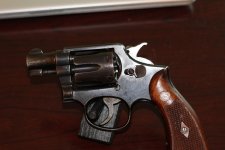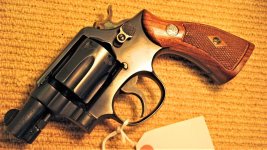You are using an out of date browser. It may not display this or other websites correctly.
You should upgrade or use an alternative browser.
You should upgrade or use an alternative browser.
Date of manufacture help
- Thread starter deno56
- Start date
Register to hide this ad
DWalt
Member
S936150, a 2" M&P, shipped in 9/47. Yours should be close. Quite a few snubbies shipped in late 1947. In fact in the SN range of S962xxx to S9635xx, almost all were square butt M&P snubbies. Note that from the hammer profile, your postwar M&P has the older-style long action. The new short action appeared at around SN S990xxx which shipped in April 1948. The older long action M&P snubbies are fairly desirable. This is mine, S970xxx (1/48):


Last edited:
That's a neat one right there all early post war features even single line address. Beautiful !
In the S935xxx through S936xxx there was a large run of 2" square butt units produced. All of those so far recorded, including one in my personal collection, shipped in September, 1947.Could someone please help me with the . . . ship date on my M&P 2in. SN# S936370.
The other large run mentioned by DWalt, in the S962xxx and S963xxx range, shipped mostly in December, 1947, with a few not going out the door until January, 1948.
I am not aware of any round butt units in these two runs. Round butt 2" guns in the S prefix period are far less common than the square butt examples. Some of them were even made up from prewar frames that had been in storage since before WWII. Nearly all of those shipped in August & September, 1946.
deno56
Here's one that lives in my safe. It has a serial number only about 400 away from yours.

Here's one that lives in my safe. It has a serial number only about 400 away from yours.

even single line address.
Well, yes. Since the 4 line address didn't start until 1948, no S prefix M&P ever had it.
iskra
Member
Thanks to all contributing here and the 'cool' guns, particularly as in centerfold quality pix'! 
I'm left wondering about the interrelationship of these late forties "S" series to the Short Action Model in "C" series. Not so much mine below, C125559, perhaps of '51, but the earlier "C" Models originating in '49. Were some of these two models actually overlapping/competing? 'IF' so, presumably to emphasize frame size differences in marketing???
Requesting clarification!
Thanks!
John
I'm left wondering about the interrelationship of these late forties "S" series to the Short Action Model in "C" series. Not so much mine below, C125559, perhaps of '51, but the earlier "C" Models originating in '49. Were some of these two models actually overlapping/competing? 'IF' so, presumably to emphasize frame size differences in marketing???
Requesting clarification!
Thanks!
John
Attachments
The short action was implemented during the S prefix series. Specifically, the first production example of the .38 M&P with the "high speed" hammer was serialized at S990184. That revolver was assembled in March, 1948, and shipped to Mesbla, Brazil on April 7, 1948. From that serial number on, to the end of the S prefix series, the vast majority of .38 M&P revolvers had the high speed hammer installed.I'm left wondering about the interrelationship of these late forties "S" series to the Short Action Model in "C" series.
When the first C prefix M&P was assembled (March 22, 1948), the high speed hammer had become standard. For all intents and purposes, all C prefix revolvers had the new short throw hammer. I have located only a single C prefix .38 M&P with the long action and it appears to have been a special order that left the factory on April 20, 1949. This, of course, is not to discuss the rare .32 M&P, which is a bit of a different animal, although built on the same frame.
Yes, assembly did overlap slightly. That appears to have only happened for a time in March and April, 1948. I've found no evidence that S prefix guns were assembled after April, 1948.the earlier "C" Models originating in '49. Were some of these two models actually overlapping/competing?
I don't know how they could be thought of as "competing." They were the same model gun. The only difference at that point was that the S series of numbers had hit the limit of six digits (S999999). So, the serial sequence was replaced with the C series. The guns did not actually change in any way at that point. As related above, the "high speed" hammer had already replaced the older long action. No new engineering changes of any significance were made again until 1956, when the fifth screw was eliminated.
I can't imagine how you would come to this conclusion. The frame size is precisely the same. All of them are K frames.'IF' so, presumably to emphasize frame size differences in marketing???
DWalt
Member
I'm left wondering about the interrelationship of these late forties "S" series to the Short Action Model in "C" series. Not so much mine below, C125559, perhaps of '51, but the earlier "C" Models originating in '49. Were some of these two models actually overlapping/competing? 'IF' so, presumably to emphasize frame size differences in marketing???
Requesting clarification!
Thanks!
John
You may be confused about frame size. The K-frames have all been dimensionally identical since 1899. The K-frame .38 Special M&P snubby originated in the mid-1930s, but very few were made prior to WWII, and a few more were made during WWII. Many more were produced during the postwar period. The only other .38 snubby produced by S&W during the postwar period was the Terrier model, built on the smaller I frame, which was chambered only in .38 S&W. In 1950 the Terrier morphed into the Chiefs Special, chambered in .38 Special. Both the Terrier and the Chiefs Special (and later, in 1952, the Centennial hammerless) had five-chambered cylinders, as opposed to the six-chambered cylinder of the larger K-frame snubbies.
Last edited:
This thread needs a shiny. 


iskra
Member
Thanks for all the info, if still getting my head around it! 
Is the inference here somehow to suggest the "high speed hammer" was some sort of 'drop in' to the "long action" frame? I'd assume there's be some considerably assembly adaptations from frame forward, but that's not what I'm hearing. Parts "fungibility", omitting only differing hammers?
Thanks for any 'pablum' explanation adaptable to Senior mind!


Best!
John
Is the inference here somehow to suggest the "high speed hammer" was some sort of 'drop in' to the "long action" frame? I'd assume there's be some considerably assembly adaptations from frame forward, but that's not what I'm hearing. Parts "fungibility", omitting only differing hammers?
Thanks for any 'pablum' explanation adaptable to Senior mind!
Best!
John
John
No, it took some fitting. I don't think I would call it a "drop in" fit. It was a major engineering change, which is why it is a demarcation point in the evolution of the M&P. Moreover, that's why "purists" insist that the M&P with the long action should not be referred to as a "pre-model 10." Personally, I don't use that terminology at all, but it is very common.
But remember that the original discussion was about the timing of the change. It happened while the S prefix was still in use. C prefix guns virtually all had the newer short throw hammer. But only roughly the last 9800 S prefix guns had the high speed hammer.
I hope this helps clear up the matter for you.
No, it took some fitting. I don't think I would call it a "drop in" fit. It was a major engineering change, which is why it is a demarcation point in the evolution of the M&P. Moreover, that's why "purists" insist that the M&P with the long action should not be referred to as a "pre-model 10." Personally, I don't use that terminology at all, but it is very common.
But remember that the original discussion was about the timing of the change. It happened while the S prefix was still in use. C prefix guns virtually all had the newer short throw hammer. But only roughly the last 9800 S prefix guns had the high speed hammer.
I hope this helps clear up the matter for you.
DWalt
Member
I have never attempted a side-by-side comparison of the two mechanisms or interchanging parts. I suspect there are differences in leverage points of the hammers which allows a shorter faster hammer fall in the high speed design. Someone here must know the design differences but I do not remember seeing it discussed. There was also another major mechanical change made in early 1945 when the improved hammer drop safety was adopted that also necessitated a change in the hammer design, that one being very apparent. But I believe the pre- and post-safety long action hammers are interchangeable, at least to the extent that they will work.
Last edited:
iskra
Member
Thanks much Gentlemen, first for putting up with my pesky questions, second for the answers provided. This a matter not on my radar previously and even though personally 'academic', I'm now left with an inference. That is "if possible", someone will have done it. If there's a value differential between long & short hammer models, possibly some unofficial "hybrids"! The "C" prefix seems at least an 'almost' assurance of factory originality as short action. Not the same degree of "factory certainty" in high SN "S" prefix where Factory specimens do exist! Would a factory letter reference such "S" Model short hammer" notation?"
Offering also the ripcord "opt out" option if my question(s) too obtuse!
Again, Gentlemen THANKS!
Best & Stay Safe!
John
Offering also the ripcord "opt out" option if my question(s) too obtuse!
Again, Gentlemen THANKS!
Best & Stay Safe!
John
Last edited:
Similar threads
- Replies
- 13
- Views
- 558
- Replies
- 2
- Views
- 244
Latest posts
-
-
WTB / WTT Looking for an original WW2 M7 Shoulder Holster for the 1911/ 1911A1
- Latest: Mister Heavyhand
-
-
-
-
-
-
-
-
-
-
-



